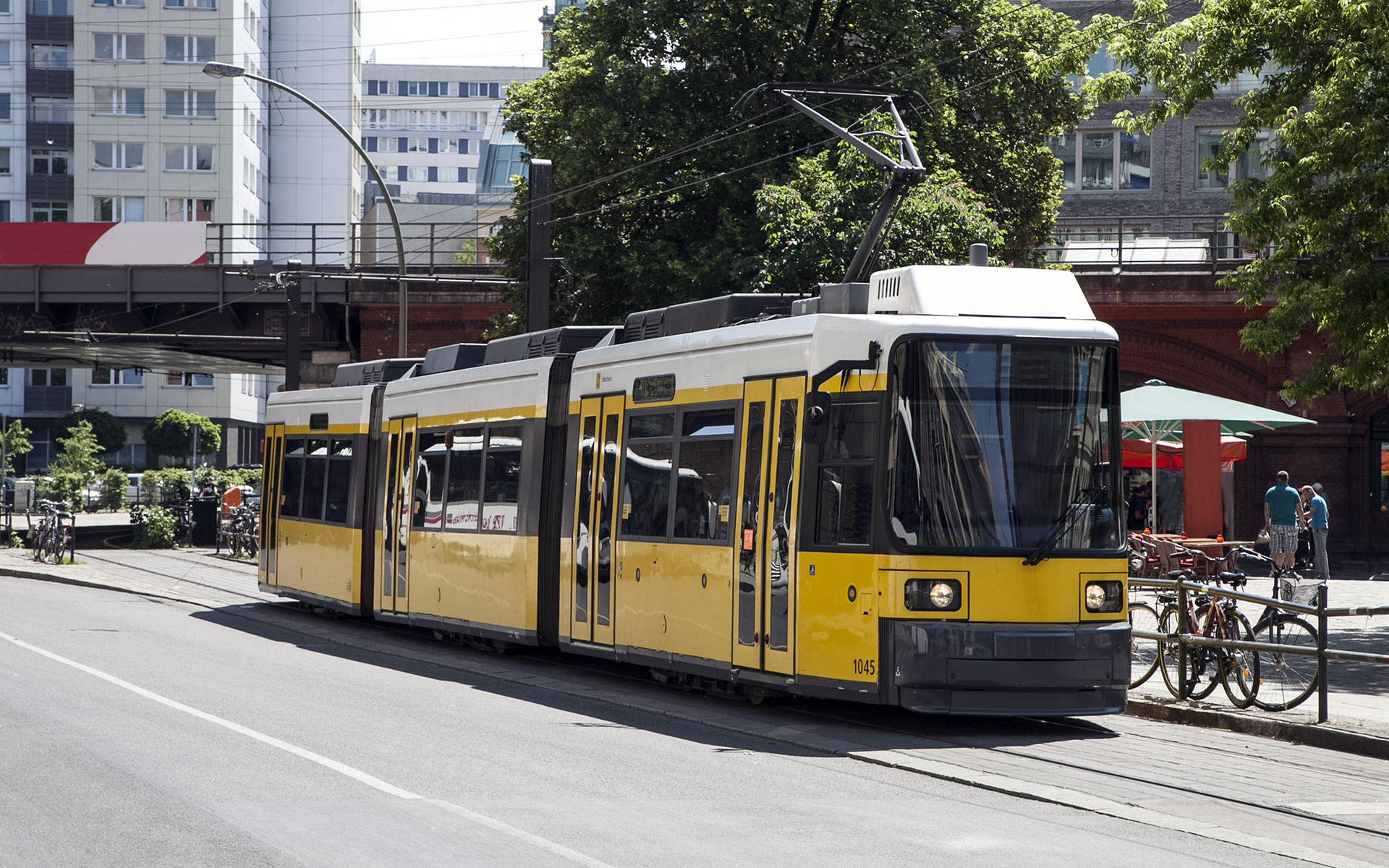The Joy of Trams
Tram in the centre of Berlin (photo © Stocktributor / dreamstime.com).
From my bedroom window in Berlin I can watch the trams pass by along the central reservation of the road below. I live in the neighbourhood of Gesundbrunnen, once part of West Berlin, where the tramlines were removed back in the 1960s when the division of the city was formalised in concrete and wire with the building of the Berlin Wall. After the Wall came down, the first line to venture back across the old border was the one that travels down my street, cresting the bridge at Bornholmer Strasse as it leaves Prenzlauer Berg behind to the east. This bridge was the point where the checkpoints were first opened on that famous November evening in 1989.
Since starting the travels that led me from northern England to making a home in Berlin, the tram has become my favourite form of urban transport. Perhaps it is because I have no memory of ever seeing them as a child growing up in England, apart from those that plied their trade along the seafront at Blackpool and the ones that opened in Manchester while I was at High School. But I had no cause to take those Manchester trams because the train from our town in Lancashire dropped us off right in the city centre.
Unless I am mistaken, the very first tram ride I ever took was in Prague, on a January day sometime in the late 1990s, from close to where we were staying in Holešovice down to and along the river, before crossing the bridge into the Old Town. I remember the crowd of people and the smell of damp clothing, as I leaned forward to try and get a view of the river through the smudged windows, snow on its banks, and the city beyond. Much of that trip is lost in my memory, or blended with other visits to Prague that would follow so that I cannot be sure of the timing, but that first tram ride remains fixed and embedded, one of those small, seemingly unimportant details that are part of what makes travel and its opportunity for discovery so special.
Thereafter, whenever I visited a city with trams, I did my best to find a reason to ride a local tram. In Sarajevo, we rode the tram from one end of the line to the other, from the city centre to the western suburbs, passing landmarks I recognised from the nightly news only a few years before, still bearing the scars of conflict. In Budapest the tram took me along the river, a Danube cruise for those inclined to seasickness. In Kraków, the tram took me safely home from a party, delivering us to a guesthouse beyond the centre, with half of the passengers asleep or drowsy from a long evening out on the town, coming round with some kind of sixth sense for their unannounced stop before stumbling down the steps and off into the darkness.
Like the western half of Berlin, there are many places where tramlines were abandoned only to be revived decades later. In 2004 I was living in Dublin during the summer when the trams returned after a 45-year absence with the opening of the Luas. I was working in the city centre, close to St Stephen’s Green, and so one afternoon in July, a few weeks after the Green Line of the Luas had started running, we climbed on board and let the tram take us out to Sandyford, which in those days was the very end of the line. On the way we were able to observe how the city changed as it passed by on the other side of the window, from the Georgian terraces of the centre to leafy suburbs and the new industrial estates and business parks feeding the Celtic Tiger.
There are many ways to explore a city, and I find that if there are trams they make for a great way to get a feel for a place. Follow a line from one end to the other and the tram tracks will lead you through a story as it unfolds, as you track the architectural shifts and the development of different neighbourhoods. These shifts are reflected in the people who climb on board. There will be stretches of the line when the tram is full and other sections when it has emptied out. Sometimes this is because the tram is crossing an unmarked and unspoken border within the city, one that only a few passengers will experience, before the other side is reached and the tram begins to fill again.
On Osloer Strasse in Berlin the trams rumble by beneath my bedroom window. Those tram lines can take me from the shore of Plötzensee lake to the banks of the River Spree in Friedrichshain. They traverse the old no-man’s land of the Berlin Wall and the new boundaries that have developed in the three decades since its fall. They offer both a means of transport but also of exploration. Mobility and adventure. In my diary I make a note of the places with trams I would like to ride one day, the ones that move through the streets of Porto and Bucharest, Brno and Basel, Minsk and, yes, after all these years, Manchester. I’m confident that each journey will offer up a story of that particular place, and will give me another memory to add to those I began to collect on that snowy Prague afternoon in another century.
1 Comment
Colin Gillies, 20 November 2020
I live in Edinburgh and our one and only tram line is currently being extended. Some people, such as I, love the teams and others hate them due to the disruption caused by the construction. Up to 1956 when the last line was closed Edinburgh had an extensive which covered most of the city. Why they closed down a good functioning transport is beyond me. I lived in Amsterdam for about 20 years and they are, at great expense, replacing some of their trams by a Metro system. The Fools. They will regret it as did most of the British cities when they scrapped their trams.

Colin Gillies, 20 November 2020
I live in Edinburgh and our one and only tram line is currently being extended. Some people, such as I, love the teams and others hate them due to the disruption caused by the construction. Up to 1956 when the last line was closed Edinburgh had an extensive which covered most of the city. Why they closed down a good functioning transport is beyond me. I lived in Amsterdam for about 20 years and they are, at great expense, replacing some of their trams by a Metro system. The Fools. They will regret it as did most of the British cities when they scrapped their trams.





About The Author
Paul Scraton
Paul Scraton was born in Lancashire and has lived in Berlin since 2001. A writer with a particular interest in landscape, memory and place, he is the editor-in-chief of Elsewhere: A Journal of Place. He is the author of a number of books including The Idea of a River: Walking out of Berlin (Readux, 2015) and Ghosts on the Shore: Travels along Germany's Baltic coast (Influx, 2017). His debut novel Built on Sand was published by Influx in 2019. Find out more about Paul on his website.